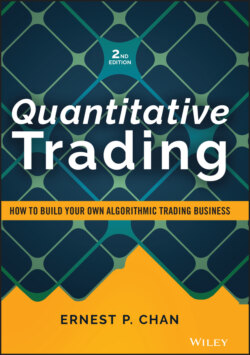Читать книгу Quantitative Trading - Ernest P. Chan - Страница 28
How Did the Performance of the Strategy Change over the Years?
ОглавлениеMost strategies performed much better 10 years ago than now, at least in a backtest. There weren't as many hedge funds running quantitative strategies then. Also, bid-ask spreads were much wider then: So if you assumed the transaction cost today was applicable throughout the backtest, the earlier period would have unrealistically high returns.
Survivorship bias in the data might also contribute to the good performance in the early period. The reason that survivorship bias mainly inflates the performance of an earlier period is that the further back we go in our backtest, the more missing stocks we will have. Since some of those stocks are missing because they went out of business, a long-only strategy would have looked better in the early period of the backtest than what the actual profit and loss (P&L) would have been at that time. Therefore, when judging the suitability of a strategy, one must pay particular attention to its performance in the most recent few years, and not be fooled by the overall performance, which inevitably includes some rosy numbers back in the old days.
Finally, regime shifts in the financial markets can mean that financial data from an earlier period simply cannot be fitted to the same model that is applicable today. Major regime shifts can occur because of changes in securities market regulation (such as decimalization of stock prices or the elimination of the short-sale rule, which I allude to in Chapter 5) or other macroeconomic events (such as the subprime mortgage meltdown).
This point may be hard to swallow for many statistically minded readers. Many of them may think that the more data there is, the more statistically robust the backtest should be. This is true only when the financial time series is generated by a stationary process. Unfortunately, financial time series is famously nonstationary, due to all of the reasons given earlier.
It is possible to incorporate such regime shifts into a sophisticated “super”-model (as I will discuss in Example 7.1), but it is much simpler if we just demand that our model deliver good performance on recent data.
